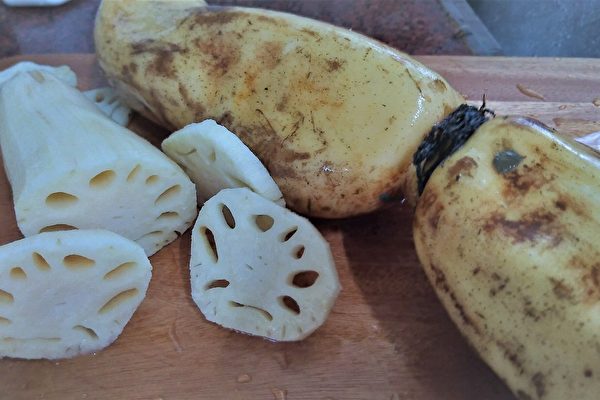Nature has bestowed mankind with a wide variety of foods, and in Taiwan, the lotus root season runs from May to October. Lotus root is slightly sweet and crispy, suitable for raw consumption or cooking. It is considered a delicacy by many, not only for its deliciousness but also for its ability to clear heat and nourish the stomach. In the eyes of traditional Chinese medicine, lotus root is a prized ingredient, with a popular saying among the people: “Lotus roots are treasures, autumn roots are most nourishing,” highlighting its high medicinal value.
In the height of summer, lotus flowers bloom magnificently. A poet once described the lotus flower with the lines: “Picking lotus blossoms on the water with green dew, harvesting lotus roots in the mud so white and fine; laughing at how they share the same roots but taste different, lotus hearts are bitter, lotus shoots are sweet.” The imagery of the lotus flower sharing the same roots but having different tastes is profound, with lotus seeds and pods growing above the water surface while lotus root grows in the mud, connected by the same root but possessing distinct flavors.
Lotus root, being the underground rhizome of the lotus plant, is rich in protein, dietary fiber, various vitamins, minerals, and other nutrients. It is often described as having a hollow inside with delicate threads, likened to “threads of emotion” by literati. The texture and cooking methods of lotus root vary based on the variety and ripeness, where the crunchy ones are suitable for salads, while the softer ones are great for soups or making lotus root powder.
According to the ancient Chinese medical book “Compendium of Materia Medica,” lotus root is called the “spiritual root,” known for aiding digestion, stopping diarrhea, strengthening the spleen, promoting appetite, clearing heat, calming the mind, enhancing wisdom, nourishing the body, and preventing internal bleeding. It is recommended to consume lotus root throughout the year, bringing joy to the heart and serving as a nourishing and beneficial food for women, children, the elderly, and individuals with weak constitutions. However, even though it is a beneficial ingredient, it should be consumed in moderation. People with a cold constitution or cold extremities should avoid excessive consumption of raw lotus root.
Currently in the lotus root harvesting season, Taiwan’s Agriculture and Food Agency of the Ministry of Agriculture has shared a comprehensive guide on lotus root on their “Fresh Enjoyment Farming YA-Agriculture and Food Agency” Facebook page, advising the public to follow 3 steps when selecting lotus root:
1. Choose lotus roots with thick and solid nodes for better quality.
2. Look for nodes with a yellow-brown color and smooth undamaged skin.
3. Opt for lotus roots with large hollow holes.
Due to its rich starch and polyphenol content, lotus root can oxidize and change color when exposed to air for long periods after peeling. To prevent this, it is recommended to soak lotus root in water before cooking to inhibit oxidation or blanch it to remove polyphenols and reduce starch content, which helps to prevent discoloration.
If you purchase a large quantity of lotus root, wrapping it in white paper and storing it in a plastic bag in the refrigerator is advisable. Lotus root with soil can be refrigerated for up to a week, while those without soil can be stored for three days. Sliced and blanched lotus root can be frozen and stored for up to a month.

